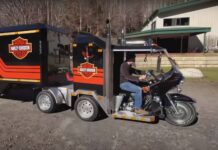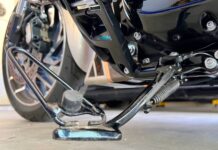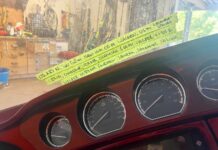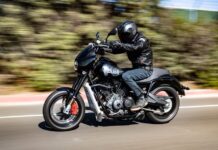Vroom. No, I mean VRRROOOOMMMM! As soon as I started her up, the throttle seemed to be stuck open—way open—scaring me half to death. I blipped the throttle a few times, made sure the handlebar idle adjustment wasn’t open, but nothing happened; it still stayed pretty near pegged. I shut her down, waited a minute or two until all the electronics had a chance to reset, and started her up again. This time, the idle settled into about 900 rpm, exactly where I wanted it to be. I just shrugged, hoping it didn’t happen again.
This became an intermittent problem with the Switchback until one day when I couldn’t get the idle to come down no matter what I did. It was so bad that I couldn’t take a chance of riding it anywhere, not even to the shop, so I took the FXD, letting the Switchback sit in the garage to think about what she’d done and why she couldn’t go out that day.
I knew I needed to figure out what’s wrong. My first thought was to check things out via the ThunderMax product that had been installed on the Switchback several years ago. I’d been shown how to connect the bike’s ThunderMax module to my laptop, which already had the TMax software installed, so I figured I’d try it. I disabled the bike’s alarm, spent about a half hour trying to pry off the electrical caddy cover to get at the ThunderMax (it replaces the stock ECM), and… no cable. Norman Gross at Sussex Hills Ltd., the shop in Sussex, New Jersey, where I had much of my ThunderMax work done, had left the TMax cable attached so I didn’t have to remove the module every time I wanted to connect it to my computer. But earlier in the year I’d had the module updated somewhere else and apparently the tech forgot to replace the cable.
I couldn’t find one that I thought would fit, so I called Ken Puzio at Black Hills Custom Parts, which isn’t far from my house, and found that he had a cable that would work. Then I had a brilliant idea. I asked if I could use some floor space in his shop to do the diagnosis and potential fix. My bright idea was that if I messed things up to the point where I couldn’t get the bike to function at all, it would already be in a shop, saving me the time, aggravation and cost of having it towed. Now all I had to do was get my bike to idle normally so I could actually ride it there. Sweet thing that she can be sometimes, she purred to life and didn’t give me a bit of trouble, allowing me to pull into the shop without any further drama.
Using a step stool as my desk, I set up my laptop (a creeper was just the right height for a chair), pulled off the electrical cover and then the TMax module, and attached one end of Ken’s cable to the back of the TMax and the other to the laptop. The TMax software came up and immediately told me I needed an upgrade. There are a ton of tech, troubleshooting, software and firmware guides on the ThunderMax site. And it was simple to download the correct version of the software into my computer.
When I tried to get the TMax software to communicate with the TMax, I got an error message. So I picked up the phone and called Matt, lead tech at Sussex Hills. Matt gave me some pointers and I finally got a good connection. (User error—thanks, Matt, for your patience.) I called again and this time Norm got on the phone and suggested I upgrade the firmware because a new version had come out in the past few months, and just updating the firmware might actually resolve the idle problem. The update went smoothly, and now I was looking at my TMax settings. Cool beans. I pressed a button to dump the activity log in case I wanted to upload it to the ThunderMax tech team for future diagnosis—easy peasy. Disconnect cable, replace TMax module, put cover on, and start. Purr.
Ken said that if the problem happens again, it could be the idle air control. I’d never even heard of the IAC, and learned that it’s the equivalent of the idle speed screw on my carbureted bikes except it can’t be adjusted manually—it has its very own motor controlled by the ECM. Ken suggested that I clean it, but I figured I’d done enough for the day. In a later conversation with Dan Pike of FTF Cycles in Randolph, Massachusetts, also a ThunderMax dealer and technician, he described in detail exactly how to clean the IAC. Even Wikipedia has an entry on this issue: “Although the IAC is supposed to last the vehicle’s lifetime, various reasons may cause it to fail/malfunction prematurely. The most common failure mode is partial/complete jamming of the actuator (due to dirt/dust or even oil) where it cannot be smoothly controlled. The result is an engine that fails to maintain idle RPM and frequently stalls. A jammed actuator may be freed simply by cleaning it.” There are even YouTube videos showing how it’s done.
More suggestions came from ThunderMax support, including the importance of general maintenance for things like a throttle cable sticking, loose battery cables causing intermittent power which can lead to the IAC getting out of sync, and quite possibly even a vacuum leak. And I’ve heard from various sources that IAC problems can occur even on bone-stock bikes. But with the ThunderMax, I can start monitoring my IAC as well as other potential problems.
The Switchback hasn’t given me a problem since then. I’m sticking by the old adage, “If it ain’t broke, don’t fix it.” I’ve got my fingers crossed that she continues to behave like a lady.



















